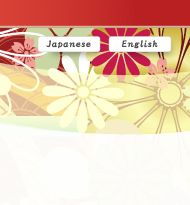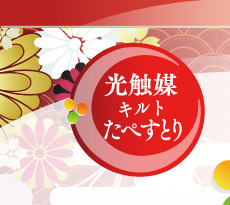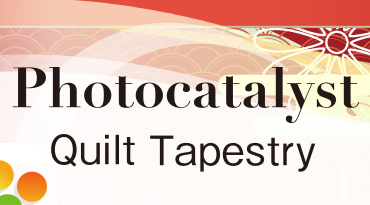


No.1 KINU-BARA-NO-KYOUEN
250cm(W)*250cm(H)These roses are created with a lot of silk threads with an advance design of log cabin quilt. This is the first work of Matsuko Shiraishi. For making this tapestry, an original sawing machine, "Wasai Kobo Himiko," which was self-developed by the company, was fully utilized.

No.1 KINU-BARA-NO-KYOUEN
250cm(W)*250cm(H)These roses are created with a lot of silk threads with an advance design of log cabin quilt. This is the first work of Matsuko Shiraishi. For making this tapestry, an original sawing machine, "Wasai Kobo Himiko," which was self-developed by the company, was fully utilized.

No.4 OYOMEIRI,NOTO-no-HANAYOME
211cm(W)*196cm(H)In the Kaga and the Noto areas, there is a traditional custom in which a bride passes through hanayome-noren (curtain-like cloth for a bride) to marry into a family. In this tapestry, this scene is depicted.

No.8 HANIKAMU, MIKANSEI
198cm(W)*165cm(H)These are roses of silk made of brocade materials. One hexagon flowing from a honeycomb structure expresses the feeling of “not finish yet.” It shows you a world of the patchwork quilting made by tessellation and a new world beginning from there.

No.28 SAKURA,SAKURA, SAKURA
Unused portions of kimono materials are jointed to express the flow of time. Cherry blossoms sprinkled are a symbol of the starting month, April, for restoration.

No.29 AKE-no-MYOJYOU
It expresses the lion dance for a festival in the Noto area. The kind of lion, so called Mukade lion, is particular in the Kaga and the Noto areas. In the Mukade lion dance for the festival, lion dancers visit to all houses in the village through a day and night. In the morning after visiting, the festival is finished by a dance of "killing the lion by a tengu, a heavenly dog," with a watch-fire.

No.30 SHISHIMAI-no-SATO
A lion dance in Himi City. This is traditional scenery in Himi.

No.31 OIDANI-no-TSUBAKI
A symbol flower and tree of Yeosu city is camellia. There are 3,000 camellia trees in Odongdo Island. As part of international exchange, there is a big camellia tree which lives for 500 years. This work depicts flowers of camellia, full in bloom in the big tree.

No.32 Morning of the summer day
Himi city is located the base of the Noto peninsula on a map. We can see the sunrise over the ocean only a few days during a year. The Japan Sea is often expressed with the words of "sever," "rough," and "gusty," however, we can enjoy the peaceful sea in summer.

No.33 ASAHI-KORE-DARUMA-NARI
The sunrise, looking like a daruma doll, over the coast in Himi is expressed. It is so rare that we don't know if we can see the daruma doll sunrise once or twice in a year. In the work the daruma doll sunrise is depicted with rugosa roses as imagery of Himi city.

No.34 u7a7a SORA
250cm(W)*200cm(H)Various skies in my memory are expressed just as they occur to my mind.

No.35 TAMASHIZUME-no-INORI
This tapestry is made with wishes for restoration from the Great East Japan Earthquake. Its motif is Guanyin. Surrounding Guanyin, there are circles, resembling prayer beads

No.36 The-dragon-breaks-a-cloud-and-climbs-the-sky
To celebrate a client company, which starts business in China, a dragon flying in the sky is made by quilting. The flying dragon is a symbol of luck.

No.37 HIKAKUKENBA-no-SORA
This is the first work of kimono quilting. A design of an antique tomesode, a black formal kimono for married women, is arranged to express a crane which is about to fly.

No.38 SOUKAKUBOTAN

